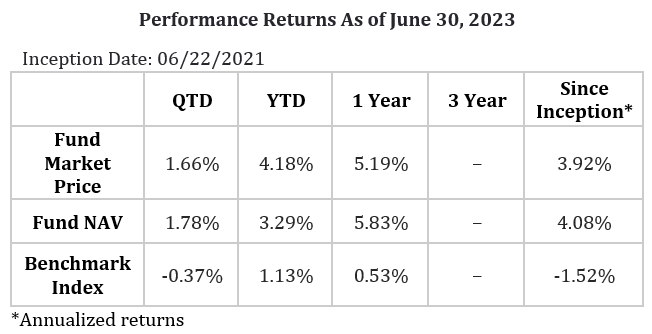
Q2 2023 Statistical Data
The Robinson Alternative Yield Pre-Merger SPAC ETF (ticker: SPAX) returned 1.66% for the second quarter of 2023 on a price basis and 4.18% for the year-to-date; it returned 1.78% on a net asset value basis for the quarter and 3.29% year-to-date. Following is the Q3 2023, YTD 2023 and trailing 2-year attribution analysis for the Fund’s NAV return relative to its benchmark index (Bloomberg 1-3 Year Govt/Credit Bond Index), as well as other absolute return and alternative yield strategies:


The total expense ratio for the Fund is 0.85%. The net expense ratio is 0.50%, based on a contractual waiver until 12/19/2023.
The performance data quoted above represents past performance. Past performance does not guarantee future results. The investment return and principal value of an investment will fluctuate so that an investor’s shares, when sold or redeemed, may be worth more or less than their original cost and current performance may be lower or higher than the performance quoted above. Performance current to the most recent month-end can be found at robinsonetfs.com/.
The Fund invests exclusively in pre-merger Special Purpose Acquisition Companies (SPACs). The “pre-merger” phase of a SPAC’s life is the only time in which it behaves similar to a bond—it has a redemption date and a redemption value that is fully collateralized by T-Bills and/or Treasury Money Market funds. Our fund, SPAX, remains the only ETF that has specifically hard-coded into its prospectus that it intends to exit any SPAC prior to the completion of a merger. The intent of the Fund is to provide a higher yielding and less volatile alternative to absolute return strategies, traditional fixed income and/or other low volatility alternative yield strategies.
Bond yields were mostly higher in the second quarter. The Fed raised short-term rates another 0.25% at its May meeting, and then paused at its June meeting; but, the Fed’s outlook is for at least two more 0.25% rate hikes. That outlook is what spooked longer-term bond investors as many of them seemed to think the Fed was done raising rates and likely to pivot to easing soon. The Fed has been adamant about getting short-term rates above the peak core inflation rate, exactly what has occurred in each of the last nine rate hike cycles of the past 50 years; and, keeping short-term rates there for an extended period of time. That would suggest to us a minimum 5.5% Fed Funds target rate (currently at 5.25%) that is held throughout 2024. Bond investors appear to have gotten the message. More important to our investors, when we launched the fund two years ago 3-month T-Bills were yielding 0.03% and today they are yielding 5.3%, and likely to go higher.
We started the quarter with 292 SPACs looking for a merger partner. Given the aforementioned environment, it was a relatively quiet quarter in terms of new SPAC issuance, 6 new SPACs, with a combined market value of $1.03 billion, came to market in the second quarter. Despite the challenging environment and the crowded field of SPACs looking for a merger partner, there were 44 deal announcements during the quarter. Another 42 pre-merger SPACs liquidated during the quarter. We ended the quarter with 215 pre-merger SPACs.
Few asset classes benefit from a hawkish Fed. Rising interest rates, as we saw for much of last year, usually hurt most traditional stock and bond valuations. Given the Fed’s intent in raising short-term rates is to slow the economy, more often than not a Fed rate hike cycle has usually ended in an economic recession. Even if the tightening cycle doesn’t end in recession, a slowing economy typically puts further downward pressure on stock valuations and upward pressure on credit spreads. Treasury Bills and Treasury Money Market Funds (which pre-merger SPACs are required to invest) are among the few assets that benefit from rising short-term rates without other consequences. A year ago, after several Fed rate hikes, the 3-month T-Bill was yielding 1.7%, it closed the second quarter with a yield of 5.3%. Following are what we believe are our top 5 reasons for WHY NOW for the Robinson Alternative Yield Pre-Merger SPAC ETF (SPAX):
-
Potential Higher Yield: the cheapest 100 pre-merger SPACs offer an annualized discount-to-current trust value of more than 2.5%, and the redemption value is growing as T-Bill yields increase. As noted above, 3-month T-Bills are now yielding 5.3%. The combination of the two results in an expected yield considerably higher than the 5.16% quarter-end yield on the Bloomberg 1-3 Year Govt/Credit Index.
-
Downside Mitigation: pre-merger SPACs have credit and interest rate risks similar to T-Bills (AAA rating), whereas the Bloomberg 1-3 Year Govt/Credit Index has an average credit quality rating of AA[5] (a notch below the credit rating of T-Bills) and a duration (a measure of a bond’s sensitivity to changes in interest rates) of 1.8 years (as an example, a hypothetical 1% rise in rates would mathematically produce a 1.8% price decline in the index).
-
Upside Potential: as we saw in previous quarters, any merger announcement shortens the time for the SPAC to earn back its discount; and, a positive market reaction to a merger announcement could potentially push SPAC prices well above their redemption values. SPACs deciding to redeem early also shorten the time horizon for us to earn back the discount at which we purchased them.
-
Opportunity for Absolute Return: pre-Merger SPACs bought at a discount can be held to redemption for an opportunity of an absolute return. At quarter-end, the cheapest 100 pre-merger SPACs were trading at an annualized discount-to-current trust value of more than 2.5% with a remaining expected average life of 5 months.
-
An Alternative Fixed Income Solution: we believe the potential for a higher yield, true downside mitigation, minimal interest rate or credit risk, and meaningful upside potential, may provide a superior alternative solution than traditional fixed income strategies.
Definitions
[1] The Bloomberg 1-3 Yr Govt/Credit Index is a broad-based benchmark that measures the performance of investment grade, US dollar-denominated, fixed-rate Treasuries, government-related and corporate securities with 1 to 3 years to maturity.
[2] The ICE 3-Month US T-Bill Index measures the performance of the 3-month US T-Bill.
[3] The HFRX Absolute Return Index measures the performance of absolute return hedge fund strategies that report their results to Hedge Fund Research.
[4] The HFRX Merger Arbitrage Index measures the performance of merger arbitrage hedge fund strategies that report their results to Hedge Fund Research.
[5] S&P ratings represent Standard & Poor’s opinion on the general creditworthiness of a debtor, or the creditworthiness of a debtor with respect to a particular security or other financial obligation. Ratings are used to evaluate the likelihood a debt will be repaid and range from AAA (excellent capacity to meet financial obligations) to D (in default). In limited situations when the rating agency has not issued a formal rating, the security is classified as non-rated (NR).
Investors should consider the investment objectives, risks, charges and expenses carefully before investing. For a prospectus or summary prospectus with this and other information about the Fund, click here. Read the prospectus or summary prospectus carefully before investing.
Risk
Investing involves risk. Principal loss is possible. ETFs may trade at a premium or discount to their net asset value. Brokerage commissions are charged on each trade which may reduce returns. A fund’s NAV is the sum of all its assets less any liabilities, divided by the number of shares outstanding. The market price is the most recent price at which the fund was traded.
The Fund invests in equity securities and warrants of SPACs, which raise assets to seek potential business combination opportunities. Unless and until a business combination is completed, a SPAC generally invests its assets in U.S. government securities, money market securities, and cash. Because SPACs have no operating history or ongoing business other than seeking a business combination, the value of their securities is particularly dependent on the ability of the entity’s management to identify and complete a profitable business combination. There is no guarantee that the SPACs in which the Fund invests will complete a business combination or will be profitable.
Some SPACs may pursue a business combination only within certain industries or regions, which may increase the volatility of their prices. To the extent a SPAC or the fund is invested in cash or cash equivalents, this may impact the ability of the Fund to meet its investment objective. Investments in a SPAC may be considered illiquid and subject to restrictions on resale.
The Fund may purchase warrants to purchase equity securities. Investments in warrants are pure speculation in that they have no voting rights and pay no dividends. They do not represent ownership of the securities, but only the right to buy them. Warrants involve the risk that the Fund could lose the purchase value of the warrant if the warrant is not exercised or sold prior to its expiration. The Fund may also purchase securities of companies that are offered in an IPO. The risk exists that the market value of IPO shares will fluctuate considerably due to factors such as the absence of a prior public market, unseasoned trading, a small number of shares available for trading and limited information about the issuer. Such investments could have a magnified impact on the Fund.
Some sectors of the economy and individual issuers have experienced particularly large losses due to economic trends, adverse market movements and global health crises. This may adversely affect the value and liquidity of the Fund’s investments especially since the fund is non-diversified, meaning it may invest a greater percentage of its assets in the securities of a particular, industry, or sector than if it was a diversified fund. As a result, a decline in the value of an investment could cause the Fund’s overall value to decline to a great degree.
The Fund is a recently organized management investment company with limited operating history and track record for prospective investors to base their investment decision.
Discount-to-redemption value: the current price of a SPAC compared to the current value of the Trust at which it can be redeemed.
The fund is distributed by Foreside Fund Services, LLC.







